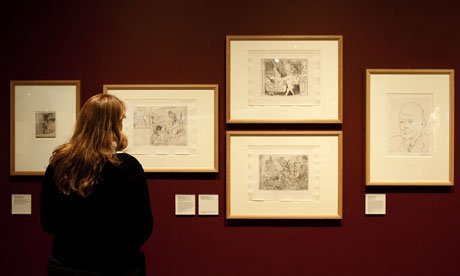British Museum puts Picasso’s Vollard Suite on display
Etchings displayed beside classical sculptures and works by Rembrandt and Goya that inspired Picasso.

Picasso's etchings at the British Museum. Photograph: Miguel Medina/AFP/Getty Images
The British Museum is showing off a spectacular new acquisition: Picasso’s most famous sequence of etchings, never before exhibited and in mint condition, and described by the museum’s director, Neil MacGregor, as “a walk inside Picasso’s mind – or other body parts”.
“Sex, antiquities and politics – what could be nicer?” MacGregor said, looking around at the 100 etchings of the Vollard Suite, displayed beside classical sculptures and works by Rembrandt and Goya that inspired Picasso. “It’s like walking around the museum by his side and seeing what interested him.”
Two years ago the museum in London owned seven plates of the series, which Picasso created in the 1930s for the art dealer Ambroise Vollard in return for some paintings including a Renoir and a Cézanne.
Stephen Coppel, curator of the modern section of the museum’s prints and drawings collection, put one on show at a small private viewing for patrons and benefactors with a caption saying it had taken the museum 30 years to collect that handful, and that it hoped one day to own the whole series.
Three months later he got an email from one of the guests, Hamish Parker, a City fund manager, saying he might be able to help. Another three months later Coppel got another email saying all the money – just over £900,000 – was in place, just at the moment a perfect complete set came on the market. “It was an astonishing act of generosity, like a fairytale,” Coppel said.
Vollard’s death in a car crash and the outbreak of the second world war prevented the publication of a planned book, and the etchings sat in a warehouse for years until they were acquired by the dealer Henri Petiet. The British Museum’s edition, the only complete set in a British public museum, was acquired directly from Petiet’s heirs.
Picasso began the sequence in a dazzle of lust for his muse and mistress Marie Therese Walter, who was 17 when he picked her up outside a Paris department store. He liked her classical straight nose, she liked his black and red tie.
She appears explicitly as a beauty from Greek mythology or hidden in the shadows of almost every etching. “The charge between model and sculptor runs like electricity through these prints,” Coppel said.
In the last prints the scene darkened from the sunny artist’s studio of the early works. Fascism was on the rise in Germany, Italy and Spain, and the swaggering, lustful Minotaur of Picasso’s imagination became a maimed, blinded, pitiful creature, led on a rope by a child-sized, helpless Marie Therese. The bombing of Guernica and Picasso’s famous response to it were just months away.
By Maev Kennedy
Source: http://www.guardian.co.uk